Metaphor and Metonymy Shaping Grammar: The role of animal terms in expressive morphology and syntax
- 格式:pdf
- 大小:769.32 KB
- 文档页数:19
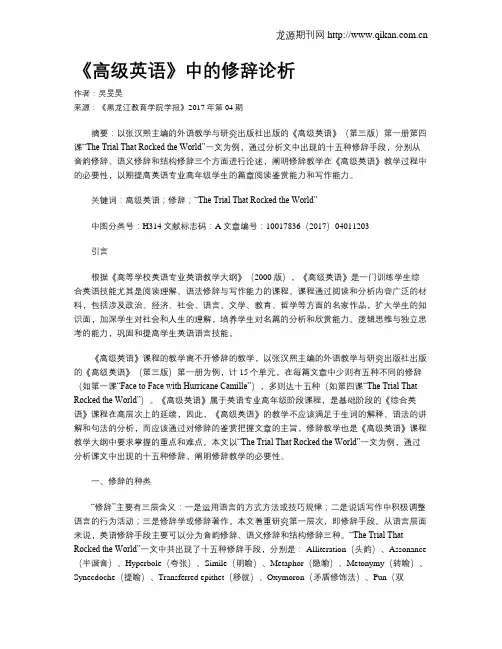
《高级英语》中的修辞论析作者:吴旻昊来源:《黑龙江教育学院学报》2017年第04期摘要:以张汉熙主编的外语教学与研究出版社出版的《高级英语》(第三版)第一册第四课“The Trial That Rocked the World”一文为例,通过分析文中出现的十五种修辞手段,分别从音韵修辞、语义修辞和结构修辞三个方面进行论述,阐明修辞教学在《高级英语》教学过程中的必要性,以期提高英语专业高年级学生的篇章阅读鉴赏能力和写作能力。
关键词:高级英语;修辞;“The Trial That Rocked the World”中图分类号:H314文献标志码:A文章编号:10017836(2017)04011203引言根据《高等学校英语专业英语教学大纲》(2000版),《高级英语》是一门训练学生综合英语技能尤其是阅读理解、语法修辞与写作能力的课程。
课程通过阅读和分析内容广泛的材料,包括涉及政治、经济、社会、语言、文学、教育、哲学等方面的名家作品,扩大学生的知识面,加深学生对社会和人生的理解,培养学生对名篇的分析和欣赏能力、逻辑思维与独立思考的能力,巩固和提高学生英语语言技能。
《高级英语》课程的教学离不开修辞的教学,以张汉熙主编的外语教学与研究出版社出版的《高级英语》(第三版)第一册为例,计15个单元,在每篇文章中少则有五种不同的修辞(如第一课“Face to Face with Hurricane Camille”),多则达十五种(如第四课“The Trial That Rocked the World”)。
《高级英语》属于英语专业高年级阶段课程,是基础阶段的《综合英语》课程在高层次上的延续,因此,《高级英语》的教学不应该满足于生词的解释、语法的讲解和句法的分析,而应该通过对修辞的鉴赏把握文章的主旨,修辞教学也是《高级英语》课程教学大纲中要求掌握的重点和难点。
本文以“The Trial That Rocked the World”一文为例,通过分析课文中出现的十五种修辞,阐明修辞教学的必要性。
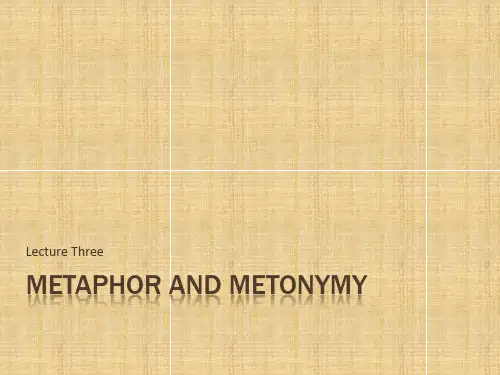
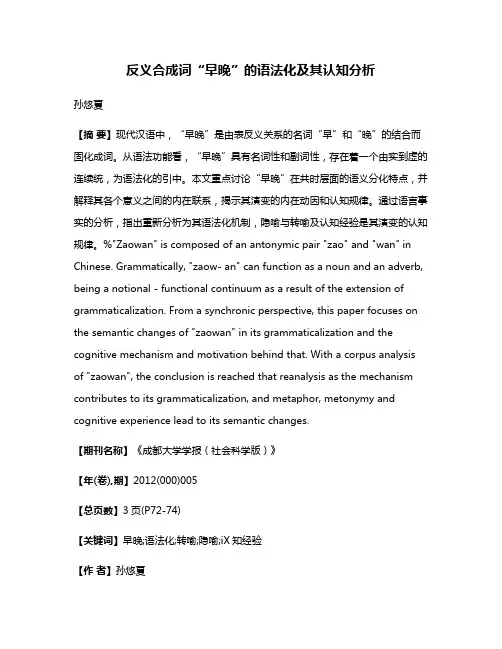
反义合成词“早晚”的语法化及其认知分析孙悠夏【摘要】现代汉语中,“早晚”是由表反义关系的名词“早”和“晚”的结合而固化成词。
从语法功能看,“早晚”具有名词性和副词性,存在着一个由实到虚的连续统,为语法化的引中。
本文重点讨论“早晚”在共时层面的语义分化特点,并解释其各个意义之间的内在联系,揭示其演变的内在动因和认知规律。
通过语言事实的分析,指出重新分析为其语法化机制,隐喻与转喻及认知经验是其演变的认知规律。
%"Zaowan" is composed of an antonymic pair "zao" and "wan" in Chinese. Grammatically, "zaow- an" can function as a noun and an adverb, being a notional - functional continuum as a result of the extension of grammaticalization. From a synchronic perspective, this paper focuses on the semantic changes of "zaowan" in its grammaticalization and the cognitive mechanism and motivation behind that. With a corpus analysis of "zaowan", the conclusion is reached that reanalysis as the mechanism contributes to its grammaticalization, and metaphor, metonymy and cognitive experience lead to its semantic changes.【期刊名称】《成都大学学报(社会科学版)》【年(卷),期】2012(000)005【总页数】3页(P72-74)【关键词】早晚;语法化;转喻;隐喻;iX知经验【作者】孙悠夏【作者单位】浙江大学外国语言文化与国际交流学院,浙江杭州310058【正文语种】中文【中图分类】H04“早晚”一词古已有之,且在现代汉语,尤其是口语中使用频率极高。
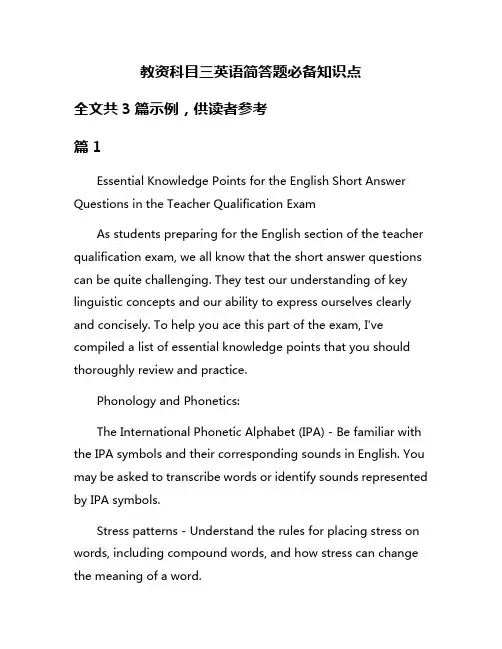
教资科目三英语简答题必备知识点全文共3篇示例,供读者参考篇1Essential Knowledge Points for the English Short Answer Questions in the Teacher Qualification ExamAs students preparing for the English section of the teacher qualification exam, we all know that the short answer questions can be quite challenging. They test our understanding of key linguistic concepts and our ability to express ourselves clearly and concisely. To help you ace this part of the exam, I've compiled a list of essential knowledge points that you should thoroughly review and practice.Phonology and Phonetics:The International Phonetic Alphabet (IPA) - Be familiar with the IPA symbols and their corresponding sounds in English. You may be asked to transcribe words or identify sounds represented by IPA symbols.Stress patterns - Understand the rules for placing stress on words, including compound words, and how stress can change the meaning of a word.Intonation patterns - Recognize the different intonation patterns used in statements, questions, and other speech acts.Phonological processes - Know common phonological processes such as assimilation, elision, and epenthesis, and how they affect the pronunciation of words.Morphology and Word Formation:Affixes - Be able to identify and explain the meanings of common prefixes (e.g., un-, re-, dis-) and suffixes (e.g., -ful, -less, -tion).Compounding - Understand the process of compounding and how it creates new words.Conversion - Recognize how words can change their part of speech without any morphological change (e.g., "a walk" as a noun and "to walk" as a verb).Acronyms and abbreviations - Know how acronyms (e.g., NATO, AIDS) and abbreviations (e.g., Dr., Ltd.) are formed and used in English.Syntax and Grammar:Parts of speech - Have a solid grasp of the different parts of speech (nouns, verbs, adjectives, adverbs, etc.) and their functions in a sentence.Phrase structure - Understand the structure of different types of phrases (noun phrases, verb phrases, prepositional phrases, etc.) and how they combine to form clauses and sentences.Clause types - Be able to identify and distinguish between different clause types (main clauses, subordinate clauses, relative clauses, etc.).Sentence types - Recognize the different sentence types (declarative, interrogative, imperative, exclamatory) and their structures.Tense and aspect - Master the usage of different tenses (present, past, future) and aspects (simple, progressive, perfect) in English.Active and passive voice - Understand the difference between active and passive voice and when to use each.Modality - Be familiar with modal verbs (can, could, may, might, must, should, etc.) and their meanings and uses.Semantics and Pragmatics:Word meanings - Understand different types of word meanings, including denotation, connotation, and figurative language (metaphor, metonymy, etc.).Semantic relations - Recognize different semantic relations between words, such as synonymy, antonymy, hyponymy, and meronymy.Speech acts - Be aware of different speech acts (requests, commands, apologies, etc.) and the appropriate language to use for each.Politeness strategies - Understand various politeness strategies (e.g., indirectness, hedging, etc.) and their role in effective communication.Conversational implicature - Recognize the concept of conversational implicature and how context influences meaning.Sociolinguistics and Language Variation:Regional and social dialects - Understand the existence of different regional and social dialects of English and the factors that contribute to their development.Language and gender - Be aware of the relationship between language and gender, including potential differences in language use and societal attitudes.Language and culture - Recognize how language and culture are interconnected, and how cultural norms and values can influence language use.Language and power - Understand the role of language in establishing and maintaining power relationships in society.Language and identity - Be familiar with the concept of language as a marker of individual and group identity.These knowledge points cover a broad range of topics in English linguistics, and mastering them will not only help you succeed in the short answer questions but also develop a deeper understanding of the English language. Remember, practice is key – try to apply these concepts to various examples and scenarios to solidify your knowledge.Good luck with your preparation!篇2Acing the Short-Answer Questions: A Comprehensive Guide to English Subject KnowledgeAs aspiring educators, we all know the pivotal role the Teacher's Qualification Examination plays in shaping our future careers. Among the various subjects, the English section can beparticularly daunting, especially when it comes to theshort-answer questions. These questions demand a concise yet comprehensive understanding of various linguistic concepts, literary devices, and pedagogical approaches. Fear not, fellow students, for I've compiled a comprehensive guide to help you navigate through this challenging terrain with confidence.Mastering the Fundamentals of English GrammarGrammatical proficiency is the bedrock of effective communication, and it's imperative for educators to possess a deep understanding of the English language's structural intricacies. From parts of speech to sentence structures, familiarize yourself with the nuances of grammar rules and exceptions. Pay close attention to concepts like subject-verb agreement, tense consistency, and proper use of punctuation. Additionally, stay updated on the latest developments in grammar guidelines, as language evolves over time.Unlocking the Power of VocabularyA rich vocabulary is a potent tool for articulating thoughts with precision and clarity. Dedicate time to expanding your lexicon by studying word roots, prefixes, and suffixes. Explore synonyms, antonyms, and idiomatic expressions to express nuanced meanings effectively. Moreover, familiarize yourselfwith academic and literary vocabulary, as these will be essential for analyzing and discussing various texts.Decoding Literary DevicesLiterature is a treasure trove of figurative language and rhetorical techniques. Develop a keen eye for identifying and interpreting literary devices such as metaphors, similes, personification, imagery, and symbolism. Understanding these devices will not only enhance your ability to analyze literary works but also enrich your own written and spoken expression.Mastering Reading Comprehension StrategiesEffective reading comprehension is a cornerstone of language proficiency. Equip yourself with strategies like skimming, scanning, inferring, and summarizing to extract essential information from texts. Practice analyzing tone, purpose, and intended audience to develop critical thinking skills. Additionally, hone your ability to identify main ideas, supporting details, and author's perspectives, as these skills will be invaluable when answering short-answer questions.Embracing Diversity in LiteratureLiterature is a mirror that reflects the richness and diversity of human experiences. Familiarize yourself with various literarygenres, from poetry and drama to novels and short stories. Explore works from diverse cultural backgrounds, time periods, and perspectives. Developing an appreciation for literary diversity will not only broaden your horizons but also foster empathy and cultural sensitivity, essential qualities for successful educators.Integrating Technology in Language LearningIn our increasingly digital age, it's crucial to understand the role of technology in language education. Explore various educational technologies, such as online learning platforms, multimedia resources, and language learning apps. Develop strategies for integrating these tools effectively into your future classrooms to engage and motivate students.Applying Pedagogical ApproachesAs future educators, it's essential to understand various pedagogical approaches to language teaching. Familiarize yourself with methods like communicative language teaching, task-based learning, and content-based instruction. Develop strategies for creating learner-centered environments that foster active participation, critical thinking, and real-world language use.Fostering Cross-Cultural CompetenceLanguage is inextricably intertwined with culture, and as educators, we must cultivate cross-cultural competence. Develop an understanding of how cultural norms, values, and beliefs influence language use and communication styles. Explore strategies for promoting cultural awareness and sensitivity in the classroom, fostering an inclusive and respectful learning environment.Embracing Continuous Professional DevelopmentEducation is a dynamic field, and it's essential to embrace a mindset of continuous professional development. Stay updated on the latest research, trends, and best practices in language teaching and learning. Attend workshops, conferences, and professional development programs to expand your knowledge and refine your teaching skills.Practicing, Practicing, and More PracticeUltimately, the key to success lies in consistent practice. Regularly attempt practice questions, mock exams, and timed exercises to develop time management skills and improve your ability to provide concise yet comprehensive responses. Seekfeedback from peers, mentors, or instructors to identify areas for improvement and refine your strategies.Remember, the journey to becoming an exceptional educator is paved with dedication, perseverance, and a genuine passion for learning. Embrace these essential knowledge points, and you'll be well-equipped to tackle the short-answer questions of the English subject with confidence and proficiency.Wishing you all the best in your endeavors!篇3Sure, here's an article on "Essential Knowledge Points for Short Answer Questions in English for the Teacher Qualification Exam," written from a student's perspective, with a length of around 2,000 words in English.Title: Essential Knowledge Points for Short Answer Questions in English for the Teacher Qualification ExamAs a student preparing for the English section of the Teacher Qualification Exam, one of the most challenging aspects is tackling the short answer questions. These questions require concise yet comprehensive responses, testing your understanding of various language concepts and teaching methodologies. To help you ace this section, I've compiled a listof essential knowledge points that you should have at your fingertips.Phonetics and Phonology:Mastering the basics of phonetics and phonology is crucial for teaching English pronunciation effectively. Familiarize yourself with the International Phonetic Alphabet (IPA) symbols, stress patterns, intonation, and the production of different speech sounds. Understanding the mechanisms behind speech production and the factors that influence pronunciation will aid you in addressing common pronunciation challenges faced by English language learners.Grammar and Syntax:A solid grasp of English grammar and syntax is indispensable for any language teacher. Be prepared to explain the rules governing sentence structure, tenses, parts of speech, clauses, and other grammatical concepts. Additionally, understand the different approaches to teaching grammar, such as deductive vs. inductive methods, and their respective advantages and limitations.Vocabulary Acquisition:Vocabulary is the building block of language learning, and as a teacher, you'll need to guide students in acquiring and retaining new words effectively. Familiarize yourself with various vocabulary teaching strategies, such as using context clues, word families, mnemonic devices, and multimedia resources. Understanding the principles of vocabulary acquisition, including the role of frequency, repetition, and meaningful contexts, will enhance your ability to facilitate vocabulary development.Reading Comprehension Strategies:Reading comprehension is a fundamental skill in language learning, and as a teacher, you should be well-versed in various reading strategies. These include skimming, scanning, making inferences, identifying main ideas, and summarizing. Understand the different reading genres (e.g., narratives, expository texts, persuasive writing) and how to adapt your teaching approach accordingly.Writing Instruction:Teaching writing is a multifaceted task that requires knowledge of the writing process, genre conventions, and effective feedback strategies. Be prepared to discuss the stages of the writing process (prewriting, drafting, revising, editing, and publishing), as well as techniques for developing ideas,organizing content, and enhancing coherence and cohesion. Additionally, familiarize yourself with various writing genres, such as narratives, descriptive essays, argumentative essays, and research papers.Classroom Management Techniques:Effective classroom management is essential for creating a conducive learning environment. Understand the principles of establishing clear routines, setting expectations, and managing student behavior using positive reinforcement strategies. Be familiar with techniques for promoting student engagement, maximizing instructional time, and fostering a respectful and inclusive classroom culture.Language Acquisition Theories:Gain a solid understanding of the various language acquisition theories, including Behaviorism, In。
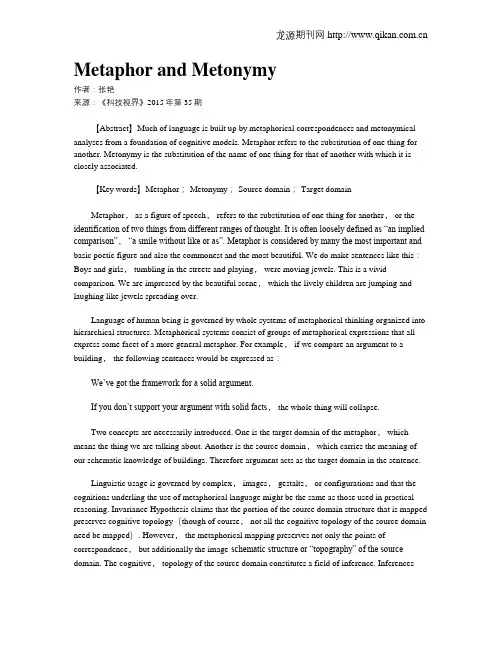
Metaphor and Metonymy作者:张艳来源:《科技视界》2015年第35期【Abstract】Much of language is built up by metaphorical correspondences and metonymical analyses from a foundation of cognitive models. Metaphor refers to the substitution of one thing for another. Metonymy is the substitution of the name of one thing for that of another with which it is closely associated.【Key words】Metaphor; Metonymy; Source domain; Target domainMetaphor, as a figure of speech, refers to the substitution of one thing for another, or the identification of two things from different ranges of thought. It is often loosely defined as “an implied comparison”,“a smile without like or as”. Metaphor is considered by many the most important and basic poetic figure and also the commonest and the most beautiful. We do make sentences like this:Boys and girls, tumbling in the streets and playing, were moving jewels. This is a vivid comparison. We are impressed by the beautiful scene, which the lively children are jumping and laughing like jewels spreading over.Language of human being is governed by whole systems of metaphorical thinking organized into hierarchical structures. Metaphorical systems consist of groups of metaphorical expressions that all express some facet of a more general metaphor. For example, if we compare an argument to a building, the following sentences would be expressed as:We’ve got the framework for a solid argument.If you don’t support your argument with solid facts, the whole thing will collapse.Two concepts are necessarily introduced. One is the target domain of the metaphor, which means the thing we are talking about. Another is the source domain, which carries the meaning of our schematic knowledge of buildings. Therefore argument acts as the target domain in the sentence.Linguistic usage is governed by complex, images, gestalts, or configurations and that the cognitions underling the use of metaphorical language might be the same as those used in practical reasoning. Invariance Hypothesis claims that the portion of the source domain structure that is mapped preserves cognitive topology(though of course, not all the cognitive topology of the source domain need be mapped). However, the metaphorical mapping preserves not only the points of correspondence, but additionally the image-schematic structure or “topography” of the source domain. The cognitive, topology of the source domain constitutes a field of inference. Inferences based upon the source domain, are taken t o apply to the target domain. Let’s look at some examples and analyze the functions.1)Snow clothes the groundThe target domain in the sentence is that snow covers the ground. It’s on the surface of the earth. The source domain turns out to be snow is the clothes wearing by the ground.2)Most Americans remember Mark Twain as the father of Huck Finn’s idyllic cruise through eternal boyhood and Tom Sawyer’s endless summer of freedom and adventure.Mark Twain is not the father of those boys in fact. Instead he is author of that book. It is he who created the well-know figures. So the source domain of father is taken to apply to the target domain of creator.3)From the discouragement of his mining failures, Mark Twain began digging his way to regional fame as a newspaper reporter and humorist.The source domain of digging his way refer to the target domain of working hard. Actually Mark Twain was not doing some specific work on his way. The adoption of the metaphor provided vivid scenery of his making efforts.4)No one, least of all I, anticipated that my case would snowball into one of the most famous trials in U.S. history.Snowball is used metaphorically as a verb. The case was not likely to be a snowball, but it grew or developed rapidly like a snowball,but it grew or developed rapidly like a snowball. It’s very clear that snowball as the source domain is taken to apply to the target domain of growing rapidly.5)He thundered in his sonorous organ tones.Could someone thunder like in a storm? Of course impossible. The sentence intended to express that he said loudly and angrily in a metaphorical and a bit hyperbolic way. Therefore thunder act as the source domain whereas crying loudly with anger is the target domain.6)Then the court broke into a storm of applause that surpassed that for Bryan.This is what we can commonly see. A storm of applause implicates the loud applause by many people. In a metaphor, one thing stands for another, or a thing is called by a name for something else. We can interpret this way: The new knowledge is likened to the old knowledge. The fitting of new knowledge to a framework of old knowledge is a basic process by which people learn complex subject matter such as “learning to play a piano or learning a language”. For some people like to extend the names for the body parts of humans and animals to refer to the parts of automobiles and pick up trucks. That’s why we say motor vehicles are anim ate things. Furthermore, we draw correspondences between their cognitive models and the cognitive models of animate beings. One complex thing has been seen and described in terms of another.Metonymy is another important figure of speech commonly u sed in language expression. It’s the substitution of the name of one thing for that of another with which it is closely associated. The relationship of one thing is close to another within a single conceptual model or scene. While any kind of association can five rise to metonymy, frequently the part stands for the whole. However,metonymy is often based not on physical relationship, but on the content of scenes. i.e.1)He is too fond of the bottle.It means he is too fond of drinking. The container (wine bottle ) is used as a name for the thing contained (wine).2)Gray hairs should be respected.The symbol(gray hair)as a name for the persons (old people) symbolized.3)I have never read LiBai.The poet( LiBai) as a name for the thing made (poems written by LiBai).4)She heard the piano.Piano stands in for the music it produces.There awaits an exciting program of semantic research to determine just how othercultures organize schemas of physical, psychological, and social forces and incorporate them into patterns of vocabulary and syntax. Our interest in the imagery underlying figurative language has now taken us form the simple appreciation of some interesting expressions to the more profound realization that much of language is built up by metaphorical correspondences and metonymical analyses from a foundation of cognitive models.【References】[1]David Nunan. Second Language Teaching and Learning[M].外语教学研究出版社,2003.[2]Jack C.Richards, John Platt, Herdi platt. Longman Dictionary of Language Teaching&Applied Linguistics[M]. 外语教学与研究出版社, 2000.[责任编辑:杨玉洁]。
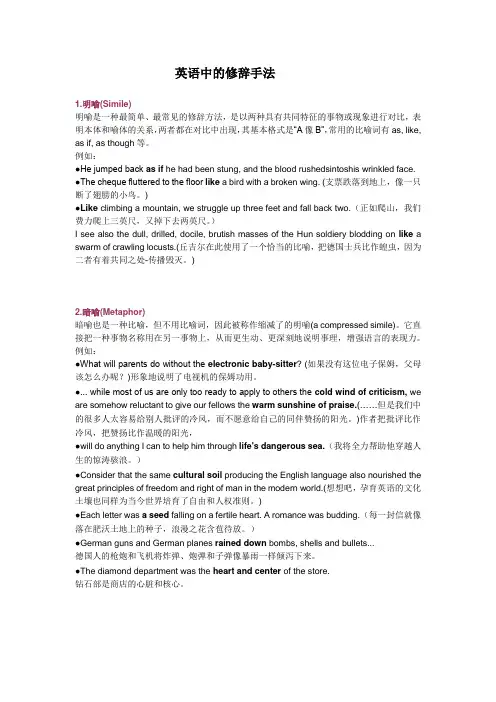
英语中的修辞手法1.明喻(Simile)明喻是一种最简单、最常见的修辞方法,是以两种具有共同特征的事物或现象进行对比,表明本体和喻体的关系,两者都在对比中出现,其基本格式是“A像B”,常用的比喻词有as, like, as if, as though等。
例如:●He jumped back as if he had been stung, and the blood rushedsintoshis wrinkled face.●The cheque fluttered to the floor like a bird with a broken wing. (支票跌落到地上,像一只断了翅膀的小鸟。
)●Like climbing a mountain, we struggle up three feet and fall back two.(正如爬山,我们费力爬上三英尺,又掉下去两英尺。
)I see also the dull, drilled, docile, brutish masses of the Hun soldiery blodding on like a swarm of crawling locusts.(丘吉尔在此使用了一个恰当的比喻,把德国士兵比作蝗虫,因为二者有着共同之处-传播毁灭。
)2.暗喻(Metaphor)暗喻也是一种比喻,但不用比喻词,因此被称作缩减了的明喻(a compressed simile)。
它直接把一种事物名称用在另一事物上,从而更生动、更深刻地说明事理,增强语言的表现力。
例如:●What will parents do without the electronic baby-sitter? (如果没有这位电子保姆,父母该怎么办呢?)形象地说明了电视机的保姆功用。
●... while most of us are only too ready to apply to others the cold wind of criticism, we are somehow reluctant to give our fellows the warm sunshine of praise.(……但是我们中的很多人太容易给别人批评的冷风,而不愿意给自己的同伴赞扬的阳光。
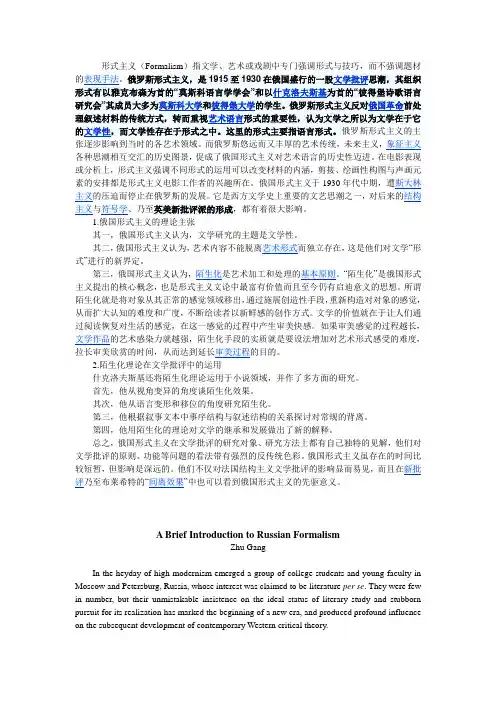
形式主义(Formalism)指文学、艺术或戏剧中专门强调形式与技巧,而不强调题材的表现手法。
俄罗斯形式主义,是1915至1930在俄国盛行的一股文学批评思潮,其组织形式有以雅克布森为首的“莫斯科语言学学会”和以什克洛夫斯基为首的“彼得堡诗歌语言研究会”其成员大多为莫斯科大学和彼得堡大学的学生。
俄罗斯形式主义反对俄国革命前处理叙述材料的传统方式,转而重视艺术语言形式的重要性,认为文学之所以为文学在于它的文学性,而文学性存在于形式之中。
这里的形式主要指语言形式。
俄罗斯形式主义的主张逐步影响到当时的各艺术领域。
而俄罗斯悠远而又丰厚的艺术传统,未来主义,象征主义各种思潮相互交汇的历史图景,促成了俄国形式主义对艺术语言的历史性迈进。
在电影表现或分析上,形式主义强调不同形式的运用可以改变材料的内涵,剪接、绘画性构图与声画元素的安排都是形式主义电影工作者的兴趣所在。
俄国形式主义于1930年代中期,遭斯大林主义的压迫而停止在俄罗斯的发展。
它是西方文学史上重要的文艺思潮之一,对后来的结构主义与符号学、乃至英美新批评派的形成,都有着很大影响。
1.俄国形式主义的理论主张其一,俄国形式主义认为,文学研究的主题是文学性。
其二,俄国形式主义认为,艺术内容不能脱离艺术形式而独立存在,这是他们对文学“形式”进行的新界定。
第三,俄国形式主义认为,陌生化是艺术加工和处理的基本原则。
“陌生化”是俄国形式主义提出的核心概念,也是形式主义文论中最富有价值而且至今仍有启迪意义的思想。
所谓陌生化就是将对象从其正常的感觉领域移出,通过施展创造性手段,重新构造对对象的感觉,从而扩大认知的难度和广度,不断给读者以新鲜感的创作方式。
文学的价值就在于让人们通过阅读恢复对生活的感觉,在这一感觉的过程中产生审美快感。
如果审美感觉的过程越长,文学作品的艺术感染力就越强,陌生化手段的实质就是要设法增加对艺术形式感受的难度,拉长审美欣赏的时间,从而达到延长审美过程的目的。
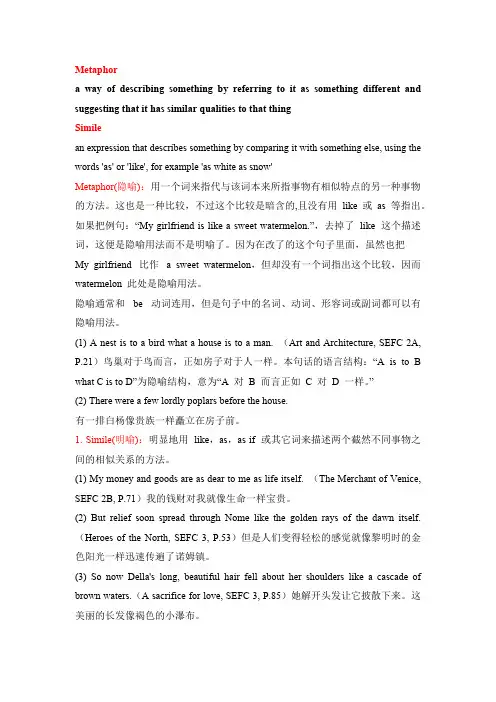
Metaphora way of describing something by referring to it as something different and suggesting that it has similar qualities to that thingSimilean expression that describes something by comparing it with something else, using the words 'as' or 'like', for example 'as white as snow'Metaphor(隐喻):用一个词来指代与该词本来所指事物有相似特点的另一种事物的方法。
这也是一种比较,不过这个比较是暗含的,且没有用like 或as 等指出。
如果把例句:“My girlfriend is like a sweet watermelon.”,去掉了like 这个描述词,这便是隐喻用法而不是明喻了。
因为在改了的这个句子里面,虽然也把My girlfriend 比作 a sweet watermelon,但却没有一个词指出这个比较,因而watermelon 此处是隐喻用法。
隐喻通常和be 动词连用,但是句子中的名词、动词、形容词或副词都可以有隐喻用法。
(1) A nest is to a bird what a house is to a man. (Art and Architecture, SEFC 2A, P.21)鸟巢对于鸟而言,正如房子对于人一样。
本句话的语言结构:“A is to B what C is to D”为隐喻结构,意为“A 对B 而言正如C 对D 一样。
”(2) There were a few lordly poplars before the house.有一排白杨像贵族一样矗立在房子前。
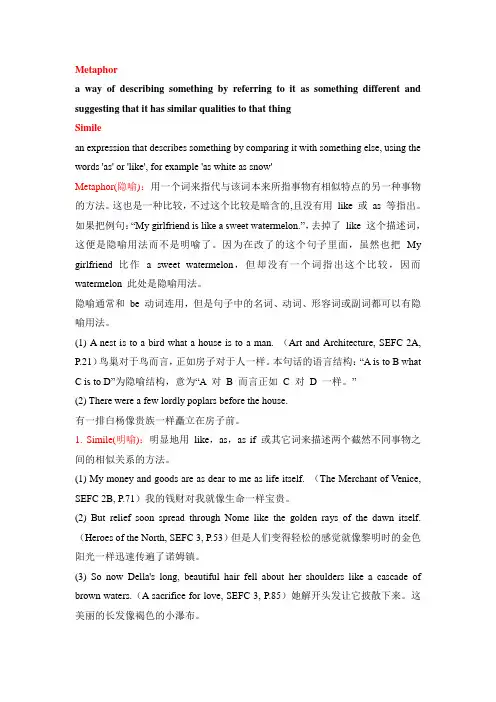
Metaphora way of describing something by referring to it as something different and suggesting that it has similar qualities to that thingSimilean expression that describes something by comparing it with something else, using the words 'as' or 'like', for example 'as white as snow'Metaphor(隐喻):用一个词来指代与该词本来所指事物有相似特点的另一种事物的方法。
这也是一种比较,不过这个比较是暗含的,且没有用like 或as 等指出。
如果把例句:“My girlfriend is like a sweet watermelon.”,去掉了like 这个描述词,这便是隐喻用法而不是明喻了。
因为在改了的这个句子里面,虽然也把My girlfriend 比作 a sweet watermelon,但却没有一个词指出这个比较,因而watermelon 此处是隐喻用法。
隐喻通常和be 动词连用,但是句子中的名词、动词、形容词或副词都可以有隐喻用法。
(1) A nest is to a bird what a house is to a man. (Art and Architecture, SEFC 2A, P.21)鸟巢对于鸟而言,正如房子对于人一样。
本句话的语言结构:“A is to B whatC is to D”为隐喻结构,意为“A 对B 而言正如C 对D 一样。
”(2) There were a few lordly poplars before the house.有一排白杨像贵族一样矗立在房子前。

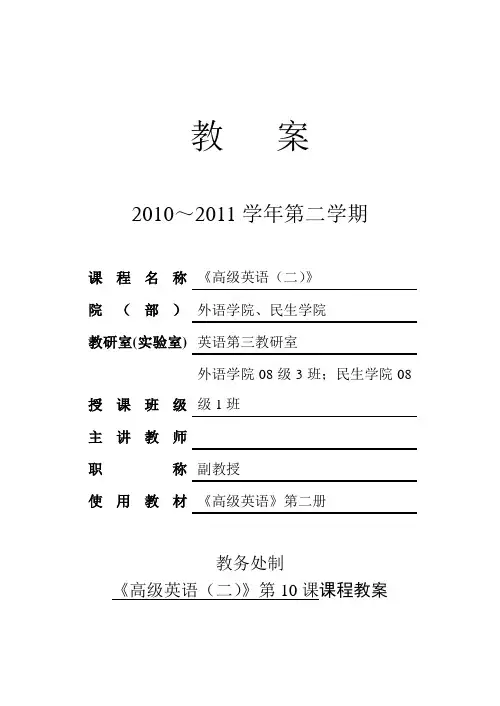
教案2010~2011学年第二学期课程名称《高级英语(二)》院(部)外语学院、民生学院教研室(实验室) 英语第三教研室授课班级外语学院08级3班;民生学院08级1班主讲教师职称副教授使用教材《高级英语》第二册教务处制《高级英语(二)》第10课课程教案附页:Advanced English (II)Lesson TenThe Sad Young MenOutline:Part One: Warm-up: Questions on the text (4 minutes)Part Two: Text Appreciation (21 minutes)I. Text Analysis(6 minutes)1. Analysis of the structure of the text (3 minutes)2. General Analysis:theme & type of writing (3 minutes)II. Detailed Study of Paragraph 1 (15 minutes)Part Three: Entention: (5 minutes)I. Discussion (3 minutes)II. Assignment (2 minutes)Part One: Warm-up: Questions on the text (4 minutes) Answer the following questions on the text:1. What do you know about the authors Rod W. Horton & Herbert W. Edwards?Rod W. Horton & Herbert W. Edwards were the joint authors of the book Backgrounds of American Literary Thought, from which this piece is taken.2. What do you know about the Sad Young Men?This term was first created by F.Scott Fitzgerald in his book All the Sad Young Men,to describe the disillusioned post-World War I younger generation,who rebelled against former ideals and values, but could replace them only by despair of a cynical hedonism.It is also termed as The Lost Generation. The remark of Gertrude Stein, “you are all a lost generation”, addressed to Hemingway, was used as a preface to the latter’s novel The Sun Also Rises.An excerpt from the preface of The Sun Also Rises:You are all a lost generation.---Gertrude Stein in C onversation ¨One generation passeth away, and another generation cometh;but the earth abideth forever... The sun also ariseth, and the sun goeth down, and hasteth to the place where he arose... The wind goeth toward the south, and turneth about unto the north; it whirleth about continually, and the wind returneth again according to his circuits. .. . All the rivers run into the sea; yet the sea is not full; unto the place from whence the rivers come, thither they return again.¨Part Two: Text Appreciation (21 minutes)I. Text Analysis(6 minutes)1. Analysis of the structure of the text (3 minutes)How does the author organize his essay?Part I (1): IntroductionThe authors introduce the subject the Sad Young Men to the readers. Part II (29):Supporting detailsThe authors supply some historical materials concerning the revolt of the younger generation in the 1920s.Part III (10-11): ConclusionThe authors arrive at the conclusion that the “lost generation” was never lost.2.General Analysis:theme & type of writing (5 minutes) Theme of the essay:The theme is summed up at the very end: The intellectuals of the Twenties, the “sad young men”, as F.Scot Fitzgerald called them, cursed their luck but didn’t die; escaped but voluntarily returned; flayed the Babbitts but loved their country, and in so doing gave thenation the liveliest, freshest, most stimulating writing in its literary experience.Type of Writing:This essay is an expository writing, explaining a certain period in American literary and social history, focusing on the attitudes and revolt of the young people who returned from WWI, disappointed and disillusioned.II. Detailed Study of Paragraph 1 (15 minutes)1. No aspect of life in the Twenties has been more commented upon and sensationally romanticized than the so-called Revolt of the Younger Generation.:No aspect of life…more…than: After WWI, during the 1920s, every aspect of life in the U.S. has been commented upon, but the so-called Revolt of the Younger Generation has been more commented upon than all other aspects.sensationally romanticized: sensationally romanticized: treated in a passionate, idealized manner to shock, thrill and rouse the interest of people.How do you paraphrase this sentence?The Revolt of the Younger Generation in the 1920s has been most commented upon and has been treated very romantically and sensationally.2. The slightest mention of the decade brings nostalgic recollections to the middle-aged and curious questionings by the young.nostalgic:V. Detailed explanation of paragraph 1 andparagraph 2. (27 minutes)Paragraph 1:While I was still a boy, I came to the conclusion that there were three grades of thinking ; and that I myself could not think at all.1.What is the main idea of this paragraph?The author puts forward the subject of thinking in the very first paragraph.2.What are the three grades of thinking?Grade-three thinking: no thinking at all, but a combination of ignorance, prejudice and hypocrisy.Grade-two thinking: the detection of contradictions.Grade-one thinking: real thinking.Paragraph 2:It was the headmaster of my grammar school who first brought the subject of thinking before me. He had some statuettes in his study. They stood on a high cupboard behind his desk. One was a lady wearing nothing but a bath towel. She seemed frozen in an eternal panic lest the bath towel slip down any farther; and since she had no arms, she was in an unfortunate position to pull the towel up again. Next to her, crouched the statuette of a leopard, ready to spring down at the top drawer of a filing cabinet. Beyond the leopard was anaked, muscular gentleman, who sat, looking down, with his chin on his fist and his elbow on his knee. He seemed utterly miserable.1.It is … that/who …The emphatic it is used to lead emphatic sentences, whose structure is :It + be (in a certain form) +emphasized part + that/who-clause. Most of the members of a sentence, except the predicate verb, may be emphasized this way:e.g. My friend gave my son an interesting novel after he came back1) 2) 3) 4)from abroad.The four underlined parts can be emphasized in the following ways:1) It was my friend who gave my son an interesting novel after hecame back from abroad.2) It was my son whom my friend gave an interesting novel afterhe came back from abroad.3) It was an interesting novel that my friend gave my son after hecame back from abroad.4) It was after he came bace from abroad that my friend gave myson an interesing novel.Note:The following adverbial clauses can not be emphasized:The adverbial clause of reason caused by since, as; the adverbial clause of concession caused by though/although; the coordinate clause caused by whereas ; the predicative.If we want to emphasize the predicate verb, we must use the pseudo-cleft sentence:e.g. My friend helped me a lot in my English study.What my friend did was to help me a lot in my English study.The squad leader was persuading the enemies to give in.What the squad leader was doing was to persuade the enemies to give in.2.lest conj. (fml 文)1). for fear that; in order that … notHe ran away lest he (should/might) be seen.他怕人家看见他而跑开了。
2004年第3期 外 国 语 总第151期 No.3, May 2004 Journal of Foreign Languages General Serial No.15126文章编号:1004-5139(2004)03-0026-09 中图分类号:H0 文献标识码:A隐喻和换喻的差别与联系束定芳(上海外国语大学,上海 200083)摘 要:传统的修辞理论把隐喻和换喻作为两个并列的修辞格。
现代认知语言学研究中有重隐喻而轻换喻的倾向。
许多隐喻理论常常把换喻作为隐喻的一个种类。
本文从结构、功能和运作机制等角度对隐喻和换喻进行分析。
作者指出,隐喻与换喻都是人类的认知手段,隐喻涉及两个不同领域事物之间的关系,而换喻常常涉及同一个认知领域的事物之间的关系。
隐喻根据的是事物之间的相似性,而换喻着重的是事物本身的特点或它与其他事物之间的特殊关系。
隐喻的理解过程实际上是源域事物特点向目标域事物映射的过程,而换喻的理解主要是根据喻体的特点来确定实际所指的对象。
从功能上来说,隐喻和换喻有很多相似之处。
但隐喻因为以此代彼,因此更能创造“诗意”和“意境”,也更具认知价值。
而换喻主要是以事物的某一特点替代该事物,因此其主要功能为指称。
关键词:隐喻;换喻;认知功能;运作机制;差别Metaphor and Metonymy: Similarities and DifferencesSHU Ding-fang(Shanghai International Studies University , Shanghai 200083, China )Abstract: Metaphor and metonymy are treated as two different figures of speech in traditional rhetoric. In modern theories of metaphor, metonymy is often regarded as a subtype of metaphor and gets a bare mention. In this paper, the author analyzes the two important phenomena in terms of their structures, functions and working mechanisms. While recognizing their similarities in certain respects, the author suggests that they are two fundamentally different cognitive devices, with metaphor involving things from two different domains and metonymy involving the properties of something and its special relations with other things. Metaphor is cognitively more useful since people often create metaphors to understand a relatively less well-known domain of things in terms of things from relatively better-known domains. As metonymy basically involves using a special property of something or its special relationship with other things to refer to it, its major function is to help the hearer to locate or recognize the referent and its special characteristics.Key words: metaphor; metonymy; cognitive functions; working mechanism; difference引 言本文讨论的“换喻”,也被称为“转喻”,包括汉语修辞格中的“借代”和“借喻”,相当于英语中的“metonymy ”,但也包括“synecdoche ”(提喻)。
研修计划题目:隐喻(metaphor)与转喻(metonymy)界面研究概要:转喻和隐喻实际上代表了基于相同认知机制所从体现的不同认知形式。
因此,如何从一个合理的思维角度处理两者的接口问题,对于认知语言学的诸多问题的解决是一个颇为重要的论题。
本文拟立足于转喻和隐喻之关系的起因、传统划界,从认知科学角度对两者接口做系统分析,从认知科学的角度将隐喻和转喻的界面研究扩展到整个人类的认知交流过程中。
本研究对隐喻和转喻的划界的研究有助于澄清语言哲学中的许多相关论题,丰富语言研究的认知科学转向,对于揭示语言活动的认知实质具有重要的科学价值和方法论意义。
文献综述:虽然隐喻和转喻的互动关系已经得到论证,但是我们依然能够很容易地区分两个不同认知过程的影响,而且它们之间的类属性互不包容。
但尽管如此,在隐喻和转喻之间还是存在一种真实的不确定性.转喻是一个认知域向另一个认知域的概念映射,两个认知域都包含在同一个理想认知模型内,源域提供通往目标域的心理通道。
Radden同时提出了以转喻为基础的隐喻这一中间概念,并认为传统定义下的转喻和隐喻可以视为位于转喻—隐喻连续体轴上两端的原型范畴,以转喻为基础的隐喻占据连续体轴上的中间模糊地带,它们体现了转喻和隐喻之间的互动关系,可以随不同的观察视角更靠近某一端。
而且,转喻和隐喻之间的区别不是离散的,而是标量的。
Radden认为, 转喻—隐喻连续体的建立机制可以从经验基础、语用含义、范畴结构和文化模式四个方面加以分析。
以转喻为基础的隐喻包括四种情况,即两个概念域具有共同的经验基础,概念域由语用含义联系,概念域涉及范畴结构,概念域由文化模式互相联系,这四种隐喻可能同时发生在某个特定情形中。
转喻和隐喻共有的经验基础首先为连续体的建立提供来源,例如,Lakoff概念隐喻MORE IS UP中垂直高度与数量之间的关系就是基于经验基础的转喻关系。
范畴结构也为隐喻的转喻基础提供了来源,范畴结构的范畴(整体)与范畴成员(部分)之间的相互指代关系本身就是转喻关系,因此,基本上所有的范畴都具有转喻系,转喻和隐喻是范畴语义拓展的两个基本途径,转喻甚至比隐喻更基本。
浅析隐喻(Metaphor)和换喻(Metonymy)的区别与联系作者:郑雅楠来源:《人间》2016年第32期(哈尔滨师范大学,黑龙江哈尔滨 150025)摘要:传统的修辞理论把隐喻和换喻作为两个并列的修辞格。
许多隐喻理论常常把换喻作为隐喻的一个种类。
本文从概念、结构、功能和运作机制等角度对隐喻和换喻进行分析两者之间的区别与联系。
关键词:隐喻;换喻;认知功能;运作机制;区别中图分类号:H05 文献标识码:A 文章编号:1671-864X(2016)11-0257-01一、隐喻与换喻的概念(一)隐喻的概念。
隐喻通常是指两个不同领域事物之间的联系,一般用于通过A事物理解或解释B事物,涉及到两个概念的映射。
(二)换喻的概念。
换喻着重的是事物本身的特点或它与其他事物之间的特殊关系,基本上是利用A事物的某一显著特征来指认该事物,基本不涉及事物特征的转移。
二、隐喻与换喻的结构(一)隐喻的结构。
从结构上来看,隐喻由“本体”,“喻体”和“喻底”三部分组成。
如:她纯洁得永远像春天像蝴蝶。
其中,“她”是本体,“春天’夕、“蝴蝶”是喻体,而“纯洁”是喻底。
需要注意的是只有符合“通过一事物来理解另一事物”才能被称为隐喻。
因此,就隐喻的本质来说,隐喻是通过某一事物来理解另外一事物。
喻体与本体之问的关系是差异中的相似。
所谓差异,指的是本体和喻体两者属于小同的领域,这是构成隐喻的基础,例如:百科全书是一座金矿。
“百科全书”与“金矿”为小同的事物,分属小同的领域。
但在这两者之问却存在着某方面的相似。
例如在上例中,说“百科全书”是“一座金矿”因为两者都“值得挖掘”,因此这就构成了一个隐喻。
(二)换喻的结构。
换喻也可以看作由三个部分组成:本体、喻体和喻底。
但与隐喻小同的是,在换喻中,本体从不出现,喻体就是喻底。
本体和喻体是以隐含的方式在起作用的。
本体和喻体之问是一种替代的关系。
而这两个事物之问并小存在一种相似的关系,喻体之所以可以替代本体,因为它代表了本体的某一特征。
metonymy and metaphor(转喻和隐喻)转喻一词来源于希腊语,意为改个名字(改变名称)。
它是英语修辞学中最常见的辞格之一。
Webster第三新国际词典对的定义比较宽泛:转喻修辞,包括使用一个事物的名字,其他的东西与它有关。
(是一种修辞格其构成是转喻,转喻,用一个事物的名称代替与它相关的另一个事物的名称。
)在汉语中通常被译为借代,也有译为换喻、转喻的。
汉语辞海对借代的定义是:甲事物同乙事物不相类似,但有不可分离的关系,利用这种关系,以乙事物来代替甲事物的,叫借代。
不管是英语中的转喻,还是汉语中的借代,都不需要把两类事物相比,它们利用的是两个事物间的联系或相关性(连接),而不是相似性(相似性)。
一般可把转喻分为九类:(一)以容器代替其内容(对事物的容器中)1。
他是个健壮的小家伙,虽然从小就被养大。
2。
壶开了。
例1中用瓶代替瓶里的牛奶。
例2中用壶代替壶里的水。
(二)用人体器官代替功能(其功能的人体器官)1。
他喜欢音乐会,因为他对音乐很有欣赏力。
2。
不知道路,你没长舌头呀!例1用代替欣赏音乐的能力例2用舌头代替说话的能力耳。
(三)用工具代替动作的实施者(为代理仪器)1。
笔的力量胜过刀剑。
2。
口诛笔伐(成语)例1用笔代替文人,剑代替武人或动武者。
例2用口代替语言工具,用笔代文字工具。
(四)用人名代替其作品或产品(为工作或产品的人的名字)1。
我从未读过莎士比亚。
2。
多读点马列。
例1用莎士比亚代替莎士比亚的作品,例2用马列代替马克思列宁主义。
(五)用事物的特征代替所指事物(指的是事物的特征)1。
白发应受到尊重。
2。
看,那个蓝眼睛来了。
1用代例白发老人。
例2用蓝眼睛代蓝眼睛的人。
(六)用人或事物代替它的特征(的人或事物的特征)还有他多的男生。
本例中用男生代学生气。
(七)用活动的场所代替事物和人(对人或事物的活动场所)1。
五角大楼还没有做出明确的决定。
2。
一人有难,八方支援。
例1中用五角大厦代领导人员在那里工作。
浅析《高级英语》中隐喻(metaphor)的运用【摘要】修辞是语言中一个重要的组成部分,有语言就有修辞。
通过修辞人们能把事物、思想、感情等具体,生动,形象地表达出来,增强语言的表达效果。
同时,修辞也是《高级英语》课程学习的一个重要内容,由张汉熙主编的《高级英语》课本中的文章都是精选的名家名篇,这些文章中使用了大量的修辞。
使文章生动传神,绘声绘色,增强了文章的感染力。
本文主要就《高级英语》课文中出现的暗喻这一修辞的运用加以论述。
【关键词】隐喻;高级英语;比喻是英语中最常用的辞格,是以比喻彼的手段。
它有一个基础,四项要素。
基础就是心理上的联想。
比喻辞格是对感知过程中产生的某种联想进行描述的一种语言艺术手法。
联想必须产生于不同类事物的比拟;同类事物的比较不构成联想,也就不构成比喻辞格。
在联想的基础上,比喻具备四个要素:(1)本体(the signified):即所要表述、描绘的对象,是被喻者。
(2)喻体(the signifier):即用来表述、描绘本体的比喻者。
(3)相似点(similarity):即联想的依据。
(4)相异点(dissimilarity):即本体与喻体之间在整体上的极不相同之处。
隐喻(又称暗喻)是比喻的一种,是以两种具有共同特征的事物或现象进行对比,表明本体和喻体在形式上的相合(be)的关系。
关于隐喻的定义,不同的书中都给了不同的释义。
亚里士多德在其名著《诗学》(Poetics)中称隐喻就是“把一个事物的名称转用于另一个事物”。
(Tropes are the application of the name of a thing to something else.密执安大学出版社1976年版的Gerald F.Else英译本)。
美国当代学者Albert Howard CarterⅢ 教授在80年代后期的研究中指出,隐喻不是单纯的点缀手段,而是具有认识论价值的语言结构。
(Metaphors are not simply ornamental devices, but linguistic structures that bear epistemological weight.)隐喻是一种感知、评估和解释世界的综合性方式(A metaphor is a synthetic way of perceiving the world, evaluating and interpreting it). 隐喻是在潜意识层上的一种感情转移(an emotional transference at a subconscious level.引自Albert Howard CarterⅢ:Metaphors in the Physician-Patient Relationships.)。